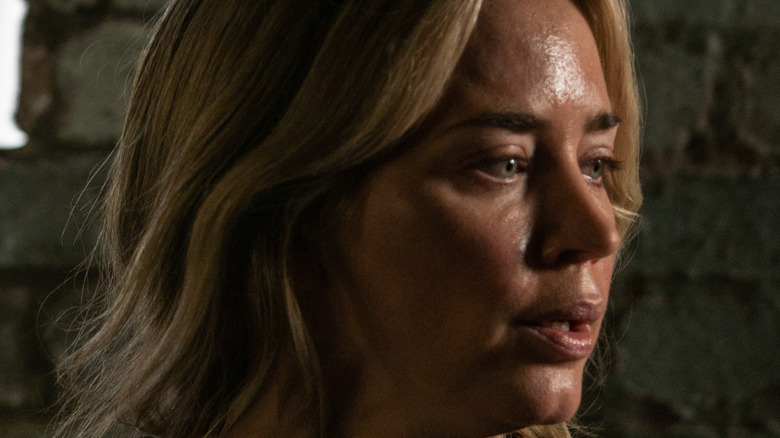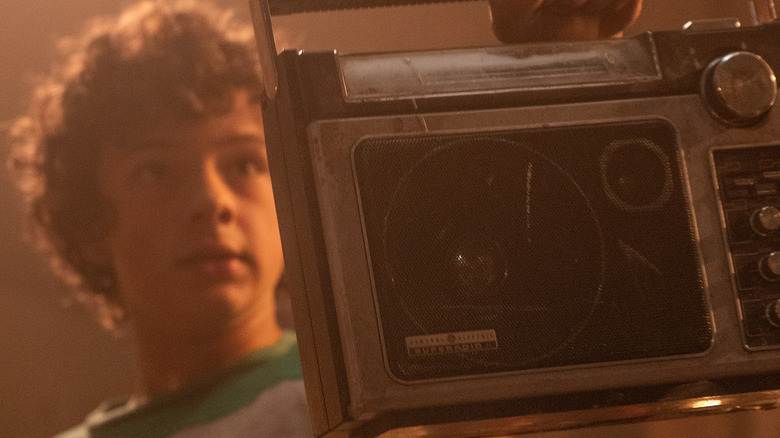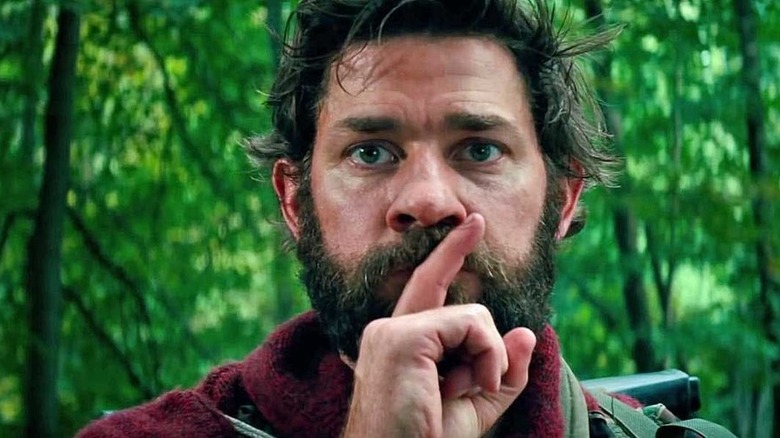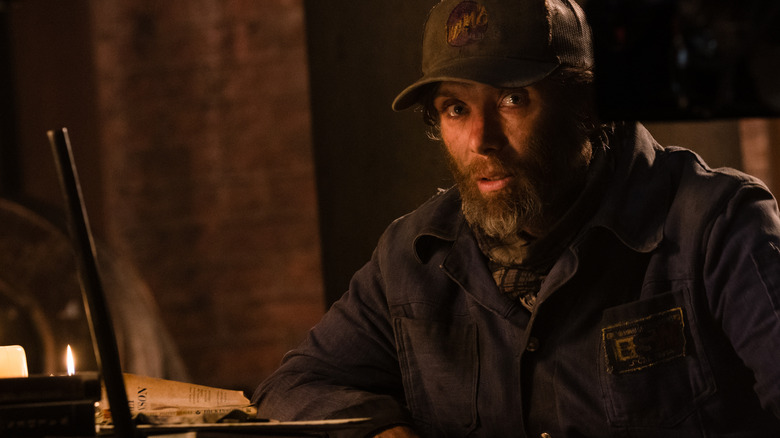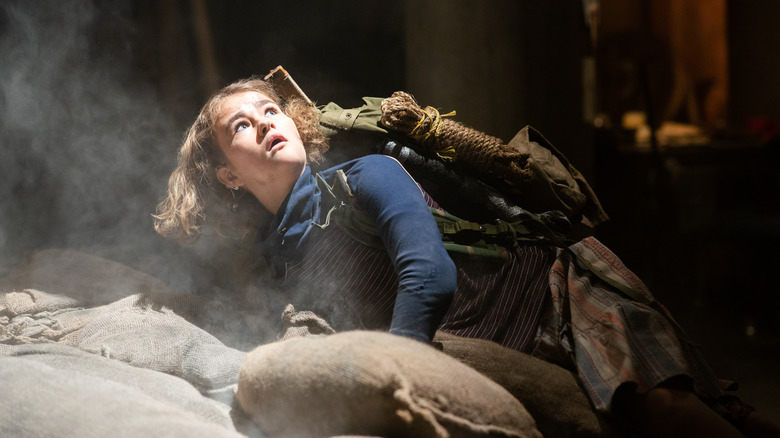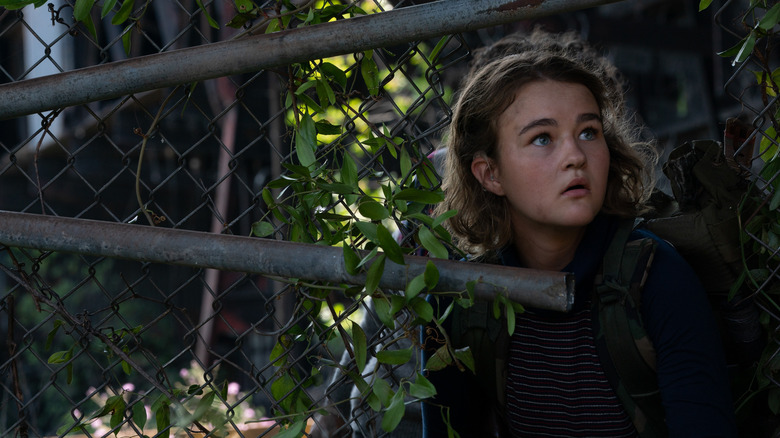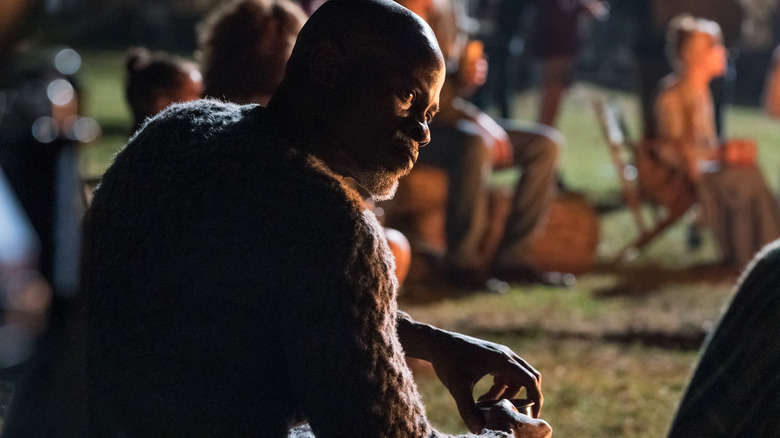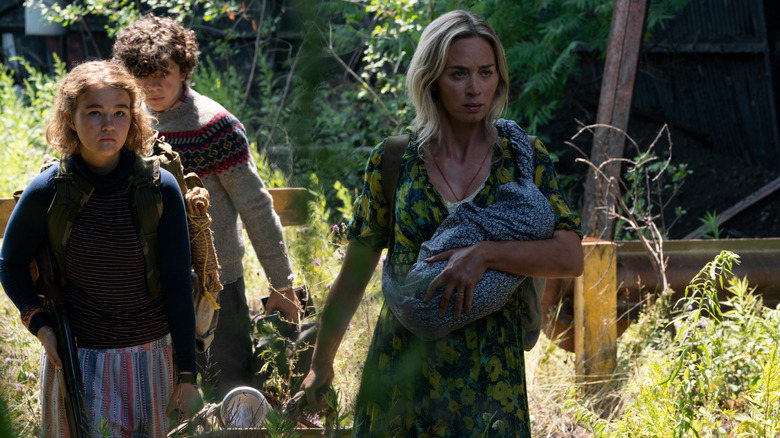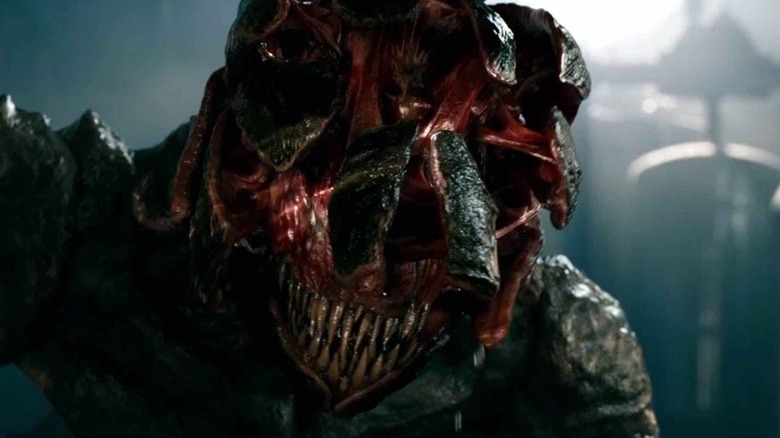The Ending Of A Quiet Place Part II Explained
Even in a movie filled with unforgettable moments, the ending of "A Quiet Place" stands out. John Krasinski's Lee Abbott is dead. His deaf daughter Regan, played by Millicent Simmonds, has discovered that her jury-rigged cochlear implant emits a sound that leaves the creatures hunting them vulnerable to attack. The Abbotts' security monitors show that two more of the monsters, sometimes called Death Angels, are mounting an attack. Regan reaches for a microphone, while Evelyn Abbott, played by Emily Blunt, cocks her shotgun and smirks.
After an intense prologue, "A Quiet Place Part II" picks up right where its predecessor leaves off. With their farmhouse in ruins, the surviving Abbotts head out into the wider world to find safety, only to discover that not everyone has taken to the post-apocalypse as gracefully as they have. During their travels, they run across an old friend, Cillian Murphy's Emmett, while Regan hatches a plan that could stop the monsters for good.
Like the first movie, "A Quiet Place Part II" is a thrilling, haunting film that doesn't let up on the tension until the striking final moments. It's not a confusing ending, but there's a lot to unpack there, so if you're not averse to some heavy spoilers, here's what you need to know about the conclusion of "A Quiet Place Part II."
An unusual coming-of-age story
Writer, director, and star John Krasinski calls the "Quiet Place" films a love letter to his children, and when "A Quiet Place Part II" ends, it's easy to see why. While the first movie is all about the sacrifices parents make to keep their children safe, the second sees the Abbott kids step up and become the heroes.
After all, it's no accident that "A Quiet Place Part II" ends with two scenes that mirror each other, featuring Regan and Marcus each killing a Death Angel. At the radio station, Regan drives a pole into one of the creatures' ears, after weakening it with her implant and a well-placed speaker. At the steel plant, Marcus shoots one of the monsters in the head, aided by the noise from Regan's broadcast.
Both of these slayings happen at the same time, and share a number of similarities. In both cases, the kids are protecting the adults around them, reversing the roles of the previous film. It's the first act of real, explicit violence from either child, and shows how their experiences in the harsh, post-apocalyptic world have changed them, not necessarily for the better.
Most importantly, though, these are two moments of huge personal growth. For Marcus, who is somehow even more anxious in "A Quiet Place Part II" than he was in the first movie, this is when he finally overcomes his fears and stands up for himself. For Regan, it marks the end of her quest. She's done her part to save the world, honoring her father's memory in the process.
The man at the middle of it all
While Regan is clearly the protagonist of "A Quiet Place Part II," the most important character in the movie may be one who's already dead. Lee Abbott, played by Krasinksi, sacrificed himself in order to save his family in the first movie, and his legacy looms large over the sequel. Lee taught Marcus the skills the boy uses to survive the movie's climax. Regan embarked on her journey to find the radio tower because, as she says, it's what Lee would've done.
That's why the opening flashback in "A Quiet Place Part II" is more than an excuse to give Krasinski some screen time. Sure, it's fun to see how everything started, and the opening invasion is full of exciting set pieces. It's not just fan service, though. Lee is central to both Regan and Marcus' arcs, so having him appear in the beginning makes the ending hit a lot harder.
While the first movie showed that Lee could be obsessive and hard-headed, his portrayal in "Part II" is overwhelmingly positive. He's a good father, a nice neighbor, and a well-liked member of the community. Showing up late to a Little League game seems to be his only flaw. In this case, that's okay. This time, Regan, Marcus, and Evelyn are dealing with Lee's memory, not the actual man. It only makes sense that we see an idealized version of him, too.
A tale of two fathers
Lee is also central to the story of Emmett, the Abbotts' former neighbor who has holed up in the old steel mill. Emmett is everything that Lee isn't. Instead of sacrificing himself to save his family, Emmett watched his wife and children die. While the Abbotts tried to make life on the farm feel as normal as possible, Emmett trades comfort for survival. Lee sought out other survivors. Emmett argues that anyone who's still alive isn't to be trusted.
The contrast between Lee and Emmett becomes even more pronounced when Emmett reluctantly agrees to accompany Regan on her trip to the radio tower, essentially becoming a surrogate father figure to the young girl. At first, Regan and Emmett seem mismatched. Emmett is gruff, impatient, and paranoid. When he disappears along with Regan's all-important implant, the girl fears the worst.
But despite his gruff exterior, Emmett is a good man, and the journey changes him. He forges a real bond with Regan, even using the limited amount of sign language he knows to protect her from danger. Once he and Regan reach the island, Emmett discovers that, much to his surprise, good people can still thrive in this world. When the monster attacks, Emmett pulls moves straight from Lee's playbook, putting himself in harm's way to save others. He draws the monster's attention away from the community by driving the truck, then puts himself in harm's way to protect Regan at the radio station.
Emmett will never take Lee's place, but by the end of the film, he's beginning to follow his old friend's example — and the world is better off for it.
A world that gets smaller as it gets bigger
"A Quiet Place Part II" expands on the world of the first movie by explaining the monsters' origins (yes, they're from space), showing how different communities have reacted to the apocalypse, and moving the action beyond the Abbotts' farm.
For Krasinski, who wrote the screenplay for "A Quiet Place Part II" on his own, this presents a conundrum. Despite the wide-open corn fields and airy feel of the Abbotts' homestead, the first "Quiet Place" movie really takes after films like "Alien" and John Carpenter's "The Thing," which trap their heroes in a confined space with a deadly, paranoia-inducing monster. Going outside the farm threatens to upend that balance, robbing the sequel of everything that makes the franchise special.
Krasinski's solution to this problem is clever. While the world gets larger in "A Quiet Place Part II," the action itself moves into increasingly small spaces. The opening flashback consumes an entire town. The first steps in the Abbots' journey take them into the wilderness. From there, they move to the steel mill, and then a small bunker inside. By the time Marcus and Evelyn reach the movie's climax, they're trapped in a cramped vault. Similarly, Regan and Emmett go from upstate New York to a remote, isolated island, and end up making their final stand in a tiny radio station.
In this way, Krasinksi ratchets up the claustrophobic tension that defined the first movie, even while broadening the series' mythology at the same time. It's a neat trick, and it's one that's not totally apparent until the final credits roll.
Fighting for freedom
"A Quiet Place Part II" plays on the confined atmosphere of the first movie in another way, too. In "Part II," all of the characters are trapped — sometimes, quite literally. Marcus steps on an actual bear trap. Emmett has a rope tied around his neck, restricting his movement. Regan ends up cornered in an old train. An entire community is stuck on an island with nowhere to run when a monster attacks, baby Abbott is kept in a box, and Marcus locks himself in the vault under the steel plant.
But the characters are mentally trapped, too. Marcus is dominated by his fear. Emmett is haunted by his inability to save his family. Regan's sense of obligation, and the example set by her father, can't be escaped. Evelyn isn't exactly shackled to her family — she protects her children because she loves them, not because she's obligated to — but as the one who ensures their survival, she's forced to undertake some risky missions, at least until the kids prove they can protect themselves.
In that light, Regan's quest takes on a different connotation. Killing the monsters isn't the goal, it's a means to an end. Regan's real mission revolves around freedom: the freedom to live a normal life, and to escape the terror that's plagued them since the alien attack began.
In the end, there's hope ... or is there?
"A Quiet Place Part II" ends on an image of hope: Regan's implant, dangling from the radio station microphone, its disruptive signal being broadcast to people all over America's east coast. We know her plan works, too. After all, we've just watched Marcus, armed with nothing more than a radio and a handgun, destroy one of the beasts that's brought civilization to its knees.
And yet, while this is clearly supposed to be a sign of positive things to come, "A Quiet Place Part II" proves time and time again that safety is an illusion. A young girl sitting on a dock may be bait, luring you in before her people attack. An island haven may seem like a peaceful refuge, but lowering your guard means you'll be unprepared when a monster attacks and slaughters your neighbors. An underground vault is a great place to hide until that towel slips, locking you inside.
And that's without taking into account the problems with Regan's plan. Are people really going to be listening to the radio without headphones in a world where sound attracts monsters? If not, how will they ever realize that the random screeching coming over the airwaves is the key to their survival?
To be fair, plot logic isn't an area where "A Quiet Place" excels — why didn't the Abbots have their baby near the waterfall, exactly? — but these are concerns that undermine the movie's final moments. In both "Quiet Place" movies, crises tend to happen when the characters begin to think they're safe. There's no indication that this isn't more of the same.
A world that's still full of mystery
While "A Quiet Place Part II" greatly expands our understanding of the post-apocalyptic world, there are a number of questions that remain when the credits begin. Narratively, it's probably for the best that these movies don't delve into the larger socio-political implications of the invasion, but there are still things we want to know about our characters that the film simply doesn't answer.
Mainly, what do Regan and Emmett do now? Do they return to the steel plant and reunite with the rest of the Abbott family, or do they wait for Evelyn, Marcus, and the baby to come to them? What is the state of the island community, now that it has been attacked by a monster, and many of its residents are dead? Will life continue there like it did before, or is that refuge gone?
As mentioned before, it's also not clear exactly how Regan's plan is going to pan out, either. It feels like there are a few more steps that need to be taken before the monsters are in real trouble. Finally, that poor baby is going to need to get a name sometime — it's been two movies, and we still don't know what the newborn is called!
Exploring other quiet places
If "A Quiet Place" performs well at the box office, a sequel seems almost guaranteed. Despite its flaws, the two movies are built on a solid premise, one that feels like it's still rife with potential. What's less obvious is whether or not the Abbotts will return. Krasinski was hesitant about returning for a sequel, and given that his real-life wife Emily Blunt plays Evelyn, it's not clear if she'd do one without him. Besides, it kind of feels like their story is over: Marcus has overcome his fear, and Regan has taken her father's place as a protector. It's not clear how much room for growth they have left.
The alien invasion was a global event, though, and radio station signals aren't infinite. There are plenty of other locations where people are probably still struggling to survive. What do things look like in big cities, or in different climates? What about other countries? Moving "A Quiet Place" out of America opens up all kinds of possibilities. In terms of the timeline, "A Quiet Place Part II" takes place about a year and a half after the initial attack. Seeing what things look like five, or 10, or 20 years down the line could also be interesting.
Wherever the series goes, we just hope future installments don't explain too much. We don't need to know what the monsters want, or why they decided to make Earth their new home. We don't need to see what happened to the government or the military. "A Quiet Place" is a series that thrives on stories about everyday people. Stick to that core, and the franchise could run for a very, very long time.
